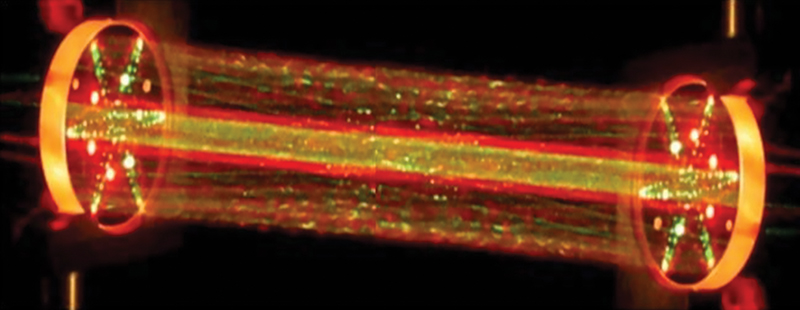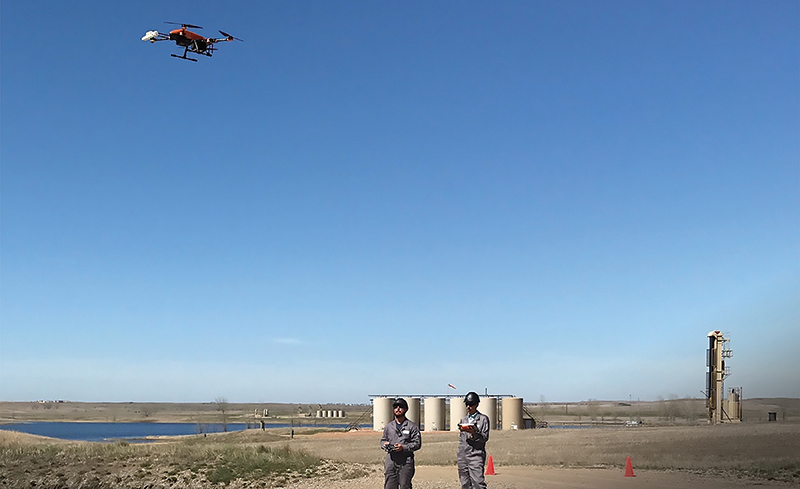
Methane Detector Sniffs Out Leaks
NASA Technology
Methane is everywhere on Earth, for better and for worse. Among other things, it’s the main ingredient in the natural gas that powers heating, cooking, and electricity. It’s also a potent greenhouse gas. So whether they’re gas producers or scientists studying climate change, there’s more than one group interested in knowing exactly how much methane is getting released into the atmosphere and where.
But the presence of methane is also interesting for a different reason: because the biggest source of the gas, on Earth at least, is bacterial life. That means when NASA planetary scientists caught a glimpse of it on Mars, it merited a closer look.
The first question, explains Jet Propulsion Laboratory (JPL) scientist Lance Christensen, was whether the methane was really there. “When you use a telescope on Earth, looking at Mars, you’re looking through our atmosphere, which has methane in it. There’s always a bit of uncertainty whether what you think is on Mars is really there,” he says.
“So the next logical step: the next time you land a rover on Mars, why don’t you sniff for it?” That’s what NASA did. A team at JPL, led by Chris Webster, built a new instrument, a tunable laser spectrometer (TLS), that can detect even minute traces of methane, measured in parts per trillion, as well as carbon dioxide and water vapor, and installed it on the Curiosity rover.
Every month or so, the rover ingests some Martian air and analyzes it with the TLS. The results show tiny traces of methane all over and, in a few spots, some bigger plumes.
Technology Transfer
Building the TLS required plenty of innovation, because previous space-ready spectrometers weren’t powerful enough, and none of the very sensitive Earth-based instruments were small enough in size, weight, or power consumption.
But technology and techniques had improved since the last Mars-bound spectrometer, and JPL was able to use these new and improved lasers, detectors, and electronics to build the tiny and powerful TLS. “That enabled us to shrink the entire system while maintaining the same level of accuracy and precision,” explains Christensen.
In fact, NASA had a big hand in improving the lasers. For methane, a laser needs to be tuned to the mid-infrared range, and NASA had done quite a bit of design on the microstructure of mid-infrared lasers, he says, to make them more efficient.
After Webster’s team built the TLS, Christensen’s role was to validate the same technique for Earth applications and then to demonstrate it to industry, because JPL knew right from the start that the Mars sniffer would also be useful to the natural gas industry.
In the end, Christensen largely redesigned the TLS for Earth applications. He wanted something even more lightweight, so it could be mounted on drones, and something that could run its analysis 10 times a second. As a trade-off, however, he made his instrument somewhat less sensitive, to 10 parts per billion, since gas leaks typically appear in the range of 50 to 100 parts per billion.
In 2013, Christensen teamed up with the Pipeline Research Council International to test a handheld version of his methane sniffer (Spinoff 2016), but he knew the commercial possibilities were bigger and that the drone-based version could work even better.
Andrew Aubrey, who worked with Christensen on this project from JPL’s National Space Technology Applications Program Office, also saw big commercial potential. He brought in funding from major oil and gas companies and coordinated and led field campaigns to demonstrate sensor performance. By 2016, Aubrey was hearing from industry contacts interested in a commercial version.
“That’s when my JPL colleague and I decided to leave JPL and spin this off as an outside company to meet demand for emission-detection services as well as sensor manufacturing,” Aubrey recalls.
He and his cofounder licensed the sensor technology from JPL and created Pasadena, California-based SeekOps in 2017.
Benefits
“Companies hire us to go out and inspect their well pads where they’re producing oil and natural gas,” Aubrey explains. “We’re able to tell them exactly where the process emissions and leak locations are.” SeekOps also inspects distribution stations and metering stations downstream from the well, to see where any loss might be happening.
Because of the powerful JPL-developed sensor and the efficiency of monitoring by drone, Aubrey says, “we’re able to do a more comprehensive job compared to traditional leak-detection operations in about a third of the time.” In fact, he says, a full well-pad inspection can take as little as 15 minutes using the SeekOps system, which is 1,000 times more sensitive than competing technologies.
Aubrey says SeeksOps delivers value for the industry in three main areas. The first is improving safety for workers and the nearby community by ensuring better detection of dangerous leaks—after all, methane is combustible, and natural gas also contains other gases that can impact health. The second, related issue, is to inspect the infrastructure and highlight any unknown hot spots or emissions that could turn into danger zones down the road. And the third is minimizing product loss.
SeekOps also helps gas producers comply with regulations that require reporting on any leaks or emissions, which aim in part to minimize the industry’s impact on climate change. “Regulations in many states are very stringent in terms of requirements for leak-detection programs,” he notes, “so we come in, and we’re able to offer a more efficient and more effective method to find emission locations to grade and quantify these emissions.”
The company is fully operational as a methane emissions inspection service across five states including California, North Dakota, Ohio, Colorado, and Texas. And, now that the service side of the business is running smoothly, Aubrey says the plan is to ramp up sensor sales.
“We make the entire SeekOps sensor system in-house, from fabricating the optical cavity to combining it with electronics and then integrating it with unmanned aerial systems,” he says. The company plans to continue offering aerial inspection services, while also selling handheld and car-mounted sensors, all based on the same core technology.
The vehicle-mounted system, which also includes a wind sensor and transmits results in real-time to a tablet mounted near the driver’s seat, can continually inspect for leaks as company technicians drive around for their everyday duties. Although these ground-level systems don’t detect leak sources as comprehensively as aerial sweeps, Aubrey notes, “they are still useful to identify potential problem areas—all during day-to-day driving operations.”
Business is growing fast, Aubrey says: a year-and-a-half in, SeekOps already had 10 employees and were adding an office in Austin, Texas. And Christensen says he hopes the gas industry won’t be the only ones receptive to the technology.
“The game plan, hopefully, is we show how useful this is for industry to measure its fugitive emissions, then the science community sees how useful this is for monitoring emissions for climate change,” he says.
For example, as the tundra warms, more swamps form, and those swamps emit methane. “Having this inexpensive system, it doesn’t cost a whole lot, and it can be used 24/7 over large areas,” says Christensen, and it could provide a lot of useful data for scientists hoping to learn more about just what’s going on in those swamps and, by extension, our atmosphere.

After designing the TLS for Mars, Jet Propulsion Laboratory engineers adapted it for use on Earth. SeekOps licensed the technology and now manufactures handheld and car-mounted sensor systems, as well as offering methane-detection services with drone-mounted sensors.

The Tunable Laser Spectrometer (TLS), installed on the Curiosity rover, was designed to measure traces of methane, carbon dioxide, and water vapor. It works by shooting lasers into a measurement chamber filled with Martian air and measuring absorption of light at specific wavelengths. This demonstration of the spectrometer used visible lasers, as opposed to the infrared lasers on the real device.













